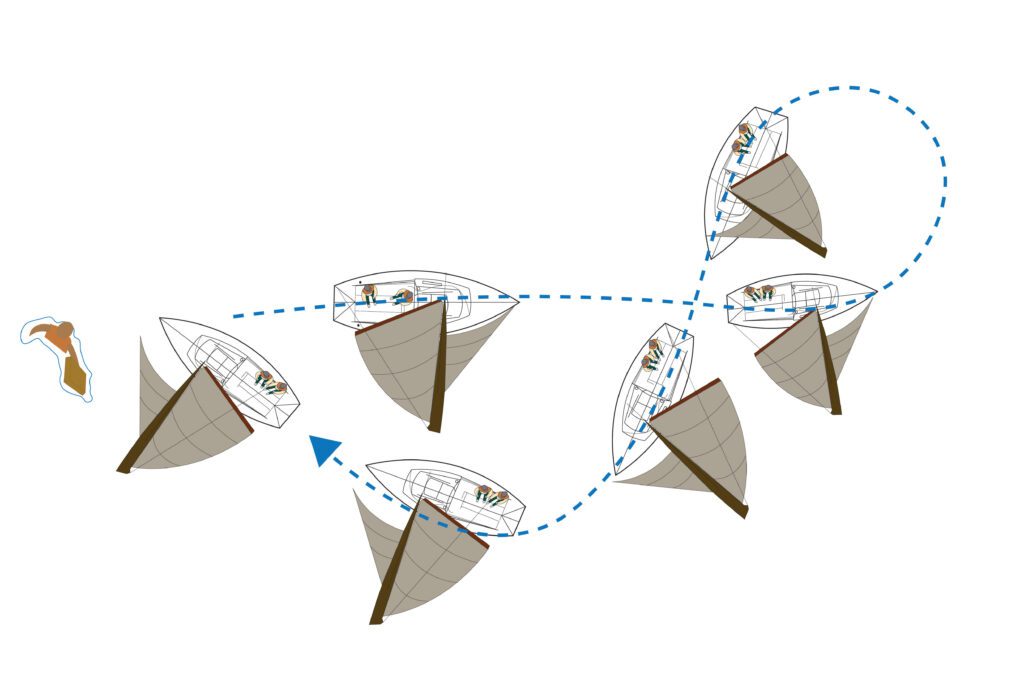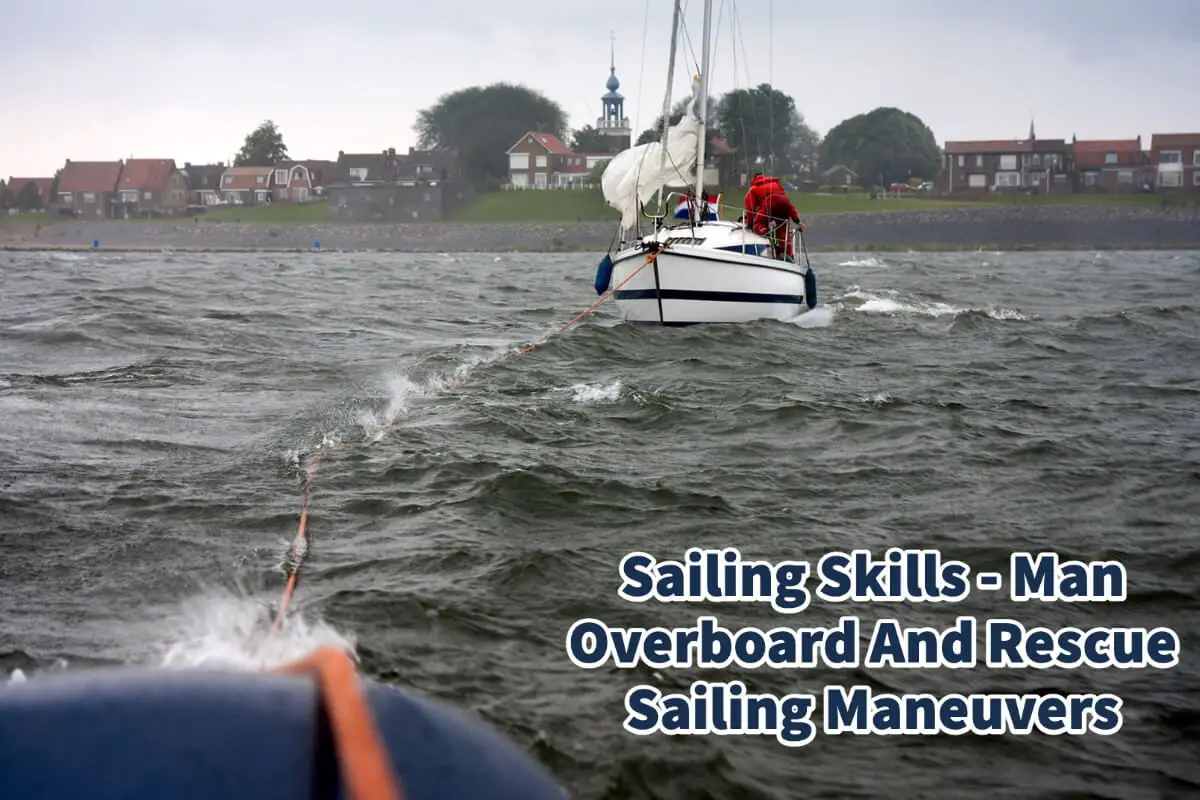If you are sailing and someone falls off a sailboat, you need to understand the process to bring them back onboard the boat. The man overboard sailing maneuver is critical; every captain must know how to rescue someone who may have gone overboard on the ship.
One of the essential skills that any sailor or sailing crew can master is the sailing skill of man overboard or rescuing a person who fell into the water. As this skill requires quick thinking, it is a sailing maneuver that should be practiced repeatedly. There are two man overboard techniques: the quick stop and Figure 8.
Table of Contents
- Sailing Skills – Man Overboard And Rescue Drill
- Two Methods To Do Man Overboard In Sailing
- Related Questions
Sailing Skills – Man Overboard And Rescue Drill
Every sailor should know how to react quickly when a crew member goes overboard. In many circumstances, this could be a difference between life and death.
One of the first things every captain needs to ensure is that those on their board are wearing a life jacket. Wearing a life jacket is especially important for anyone sailing a smaller sailboat, catamaran, or dingy.
There are two different ways to conduct an overboard man drill or rescue has seven steps that must take place.
7 Steps For Every Man Overboard Rescue
Every sailor must know how to react quickly to a man overboard. But with responding quickly, there are also seven basic steps that every captain must ensure:
- Throw The Person Is In The Water (PIW) A Floating Device – The person in the water should come to the surface. Throw an object of buoyance to them as a lifejacket, buoyance, or floating device. If you are doing a Man Overboard drill, you need to use buoyancy and rope that will remain on the top of the water’s surface.
- Keep The Person In Water (PIW) Insight – You must keep the person in the water in sight. The captain can assign one person to continuously point to where the person is in the water so that you do not lose sight of them.
- Head The Boat Back To The Person In The Water – You need to head the boat back to the person in the water.
- Stop The Boat Alongside The Person In The Water – The captain needs to steer the boat alongside the person in the water.
- Make Contact With The Person In The Water – The captain and other crew members need to contact the person in the water.
- Attach The Person In The Water To The Boat – Next, you must ensure the person in the water is attached to the boat.
- Pull Up The Person In The Water To The Boat – You need to pull the person in the water safely or get them back on the boat.
Two Methods To Do Man Overboard In Sailing
Two methods can be used to do man overboard in sailing. One is called the Quick Stop, and the other is the Figure 8 method.
Here is how each of these maneuvers works:
Quick Stop Method Of Rescue For Man Overboard In Sailing
The Quick Stop Method of Rescue for a Man Overboard in Sailing is about an immediate reduction in speed while keeping your eye on the man overboard. You essentially go into a circle to rescue the person in the water.
Here are the steps you need to take for the Quick Stop Method of Rescue for Man Overboard in Sailing:

- Shout Crew Overboard And Throw Over A Bouyance Object to Man Overboard. The captain or other crew member should shout ”Crew Overboard” and throw a buoyance object to the person overboard as a life jacket, buoyance, or life ring. This action must be quick as the buoyancy object must be thrown near where the person has gone overboard.
- Designated Spotter – The captain needs to assign a designated person to be the spotter, and that person should constantly point and NEVER take their eyes off the person in the water.
- Bring The Boat Into The Wind – The captain should bring the boat into the wind. Both the mainsail and jib should be trimmed to reduce speed. The captain should continue to turn the boat into the wind. Hold this course until you are almost alongside the person overboard.
- Trim the Jib – Trim the jib sail of the boat to lower the sailboat’s speed.
- Make Contact With Person Overboard – Contact the person who is overboard and let them know what you will do.
- Ease The Sails – Stop the boat alongside the Person In the Water and throw an object that attaches them to the boat.
- Bring the person in the water onto the boat.
Figure 8 Method Of Rescue For Man Overboard In Sailing
The Figure 8 method of rescue for the man overboard in sailing is similar to the quick stop method, except you will be doing a Figure 8 to pick up the person in the water or the man overboard.

Here are the steps you need to take for the Figure 8 Method of Rescue for Man Overboard in Sailing:
- Shout Crew Overboard And Throw Over A Bouyance Object To Man Overboard – The captain or other crew member should shout ”Crew Overboard” and throw a buoyance object to the person overboard as a life jacket, buoyance, or life ring. This action must be quick as the buoyant object must be thrown near where the person has gone overboard.
- Designated Spotter – The captain needs to assign a designated person to be the spotter, and that person should constantly point and NEVER take their eyes off the person in the water.
- Bring Boat Four Boat Lengths Forward – Count four boat lengths forward and then turn the boat around towards the person in the water.
- Trim the Jib of the boat to lower the speed of the boat.
- Steer the boat in Figure 8 towards the person in the water.
- Make Contact With Person Overboard – Contact the person overboard and let them know what you will do.
- Ease The Sails – Stop the boat alongside the Person In the Water and throw an object that attaches them to the boat.
- Bring the person in the water onto the boat.
The man overboard sailing maneuver is a vital sailing skill to learn.
The man overboard is a skill that you should practice time and time again when you are out on the water to make sure that you and your crew do not forget all steps needed for a proper man overboard; the difference between practicing it and not practicing it could make a difference between life and death.
At A Bus On A Dusty Road, we talk about everything about travel, life, sailing, and ex-pat living. We are all about “Living Life As A Global Citizen.” We explore social, cultural, and economic issues and travel.
We would love to have you be part of our community. Sign up for our newsletter to keep up-to-date by clicking here. If you have any questions, you can contact me, Anita, by clicking here.
Listen to our Podcast called Dusty Roads. You can find it on all major podcast platforms. Try out listening to one of our podcasts by clicking here.
Subscribe to our A Bus On A Dusty Road YouTube Channel with great videos and information by clicking here.
Related Questions
Milwaukee Community Sailing Center, Top US Sailing School
Milwaukee community sailing center is located on Lake Michigan in downtown Milwaukee Wisconsin. The sailing center is registered as a charity whose primary focus is to teach basic, intermediate, and advanced sailing classes to adults, youth, and children. They are also a charity 501c3 organization that helps many underprivileged children learn the art of sailing.
By clicking here, you can discover Milwaukee Community Sailing Center, Top US Sailing School.
How Much Wind Is Too Much For A Beginner Sailor?
For a beginner sailor, the wind is usually recommended to be under 10 knots. Those who are more experienced or with a larger boat can consider going up to 12 knots of wind. A knot is not the same as miles per hour or kilometers per hour but is faster than these measurements.
By clicking here, you can discover How Much Wind Is Too Much For A Beginner Sailor?
No Experience Sailing, 6 Tips To Get Started
If you are going to take up sailing, you first must get on a boat and find out if sailing is suitable. The best sailors can handle their boats in all kinds and types of weather. Find a class that you can join and get certified. Sailing requires knowledge and skill. Find yourself a sailing community that you can be part of.
By clicking here, you can discover No Experience Sailing, 6 Tips To Get Started.


